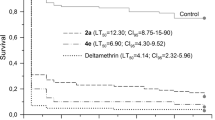Abstract
The arctiid mothHyalurga syma (subfamily Pericopinae) sequesters pyrrolizidine alkaloids (PAs) from its larval food plantHeliotropium transalpinum (Boraginaceae). Colorimetric quantification of total PAs in the larvae, pupae, and adults ofHyalurga revealed mean values of about 286–445μg per individual (1.4–2.6% of dry weight). The PA mixtures found in the moth and its larval food plant were evaluated by GC-MS. Food-piant leaves were found to contain the diastereoisomeric retronecine esters indicine (IIIa), intermedine (IIIb), and lycopsamine (IIIc), and the heliotridine ester rinderine (IIId) only as minor constituents, whereas 3′-acetylrinderine (IVc) (68% of total PAs) and the respective 3′-acetyl esters of indicine (IVa) and intermedine (IVb) (both 17%) were the major alkaloids. Supinine (IIa) is detectable in traces only. The PA mixtures in eggs, larvae, pupae, and imagines ofHyalurga were identical: indicine, intermedine, and lycopsamine accompanied by considerable amounts of supinine and amabiline or coromandalinine (IIb/IIc) were the major components. Only larvae were found to store small quantities of a 3′-acetyl derivative. Rinderine and its 3′-acetyl ester were never found in the insects. Low concentrations of the arctiidspecific PA callimorphine (I) were present in larvae, pupae, and imagines. The differences in the PA patterns of the insects and their larval food plant suggest thatHyalurga is capable of modifying plant-derived PAs by inversion of the 7-OH configuration (conversion of the necine base heliotridine into retronecine), and perhaps the inversion of the 3′-OH [conversion of (+)-trachelanthic acid into (−)-viridifloric acid], although the possibility of a selective sequestration of the respective retronecine esters cannot be excluded. Some trials with the orb-weaving spiderNephila clavipes, a common neotropical predator, showed that both freshly emerged and field-caught adults ofHyalurga syma are liberated unharmed by the spider. The liberation could be related to the presence of PAs in the moths.
Similar content being viewed by others
References
Bingley, J.B. 1968. Solvent and temperature effects in the determination of pyrrolizidine alkaloids with 4-dimethylaminobenzaldehyde.Anal. Chem. 40:1166–1167.
Boppré, M. 1986. Insects pharmocophagously utilizing defensive plant chemicals (pyrrolizidine alkaloids).Naturwissenschaften 73:17–26.
Boppré, M. 1990. Lepidoptera and pyrrolizidine alkaloids. Exemplification of complexity in chemical ecology.J. Chem. Ecol. 16:165–185.
Bowers, M.D. 1988. Chemistry and coevolution: Iridoid glycosides, plants, and herbivorous insects, pp. 133–165,in K.C. Spencer (ed.). Chemical Mediation of Coevolution. Academic Press, New York.
Brower, L.P. 1984. Chemical defense in butterflies.Symp. R. Entomol. Soc. London 11:109–134.
Brown, K.S. 1984. Adult-obtained pyrrolizidine alkaloids defend ithomiine butterflies against a spider predator.Nature 309:707–709.
Brown, K.S. 1985. Chemical ecology of dehydropyrrolizidine alkaloids in adult Ithomiinae (Lepidoptera: Nymphalidae).Rev. Bras. Biol. 44:435–460.
Brown, K.S. 1987. Chemistry at the Solanaceae/Ithomiinae interface.Ann. Mo. Bot. Gard. 74:359–397.
Duffey, S.S. 1980. Sequestration of plant natural products by insects.Annu. Rev. Entomol. 25:447–477.
Ehmke, A., Witte, L., Biller, A., andHartmann, T. 1990. Sequestration, N-oxidation and transformation of plant pyrrolizidine alkaloids by the arctiid mothTyria jacobaeaeL.Z. Naturforsch. 45c:1185–1192.
Eisner, T. 1982. For love of nature: exploration and discovery at biological field stations.BioScience 32:321–326.
Hartmann, T. 1991. Alkaloids, pp. 79–121.in D.E. Janzen and G. Rosenthal (eds.). Herbivores: Their Interactions with Secondary Plant Metabolism, 2.ed., Academic Press, New York.
Hartmann, T., andToppel, G. 1987. Senecionine N-oxide, the primary product of pyrrolizidine alkaloid biosynthesis in root cultures ofSenecio vulgaris.Phytochemistry 26:1639–1643.
Hartmann, T., Biller, A., Witte, L., Ernst, L., andBoppré, M. 1990. Transformation of plant pyrrolizidine alkaloids into novel insect alkaloids by arctiid moths (Lepidoptera).Biochem. Syst. Ecol. 18:549–554.
L'empereur, K.M., Li, Y., andStermitz, F.R. 1989. Pyrrolizidine alkaloids fromHackelia californica andGnophaela latipennis, anH. californica-hosted arctiid moth.J. Nat. Prod. 52:360–366.
Kovats, E. 1958. Gas-chromatographische Charakterisierung organischer Verbindungen. Teil 1: Retentionsindices aliphatischer Halogenide, Alkohole, Aldehyde und Ketone.Helv. Chim. Acta 41:1915–1932.
Mattocks, A.R. 1967a. Spectrophotometric determination of unsaturated pyrrolizidine alkaloids.Anal. Chem. 39:443–447.
Mattocks, A.R. 1967b. Detection of pyrrolizidine alkaloids on thin-layer chromatograms.J. Chromatogr. 27:505–508.
Mattocks, A.R. 1968. Spectrophotometric determination of pyrrolizidine alkaloids-some improvements.Anal. Chem. 40:1749–1750.
Mattocks, A.R., Schoental, R., Crowley, H.C., andCulvenor, C.C.J. 1961. Indicine: The major alkaloid ofHeliotropium indicumL.J. Chem. Soc. 1961:5400–5403.
Mohanraj, S., Subramanian, P.S., andHerz, W. 1982. Minor alkaloids ofHeliotroium curassavicum.Phytochemistry 21:1775–1779.
Nickisch-Rosenegk, E., Schneider, D., andWink, M. 1990. Time course of pyrrolizidine alkaloid processing in the alkaloid exploiting arctiid moth,Creatonotos transiens.Z. Naturforsch. 45c:881–894.
Pedersen, E., andLarsen, E. 1970. Mass spectrometry of some pyrrolizidine alkaloids.Org. Mass Spectrom. 4:249–256.
Roitman, J.N. 1983. The pyrrolizidine alkaloids ofAmsinckia menziessi.Aust. J. Chem. 36:769–778.
Robins, D.J. 1989. Biosynthesis of pyrrolizidine alkaloids.Chem. Soc. Rev. 18:375–408.
Trigo, J.R. 1988. Ecologia química na interaçāo Ithomiinae (Lepidoptera: Nymphalidae)/Echitoideae (Angiospermae: Apocynaceae). MSc thesis. Instituto de Biologia, UNICAMP, Campinas, São Paulo, Brazil, 196 pp.
Vasconcellos-Neto, J., andLewinsohn, T. 1984. Discrimination and release of unpalatable butterflies byNephila clavipes, a neotropical orb-weaving spider.Ecol. Entomol. 9:337–344.
Vianna, M.J.B. 1972. Contribuição à biologia deNephila clavipes L. (Araneae, Araneidae). PhD thesis. Faculdade de Ciências Médicas e Biológicas de Botucatu, Sāo Paulo, Brazil, 154 pp.
Wink, M., Schneider, D., andWitte, L. 1988. Biosynthesis of pyrrolizidine alkaloid-derived pheromones in the arctiid moth,Creatonotos transiens: Stereochemical conversion of heliotrine.Z. Naturforsch. 43c:737–741.
Author information
Authors and Affiliations
Rights and permissions
About this article
Cite this article
Trigo, J.R., Witte, L., Brown, K.S. et al. Pyrrolizidine alkaloids in the arctiid mothHyalurga syma . J Chem Ecol 19, 669–679 (1993). https://doi.org/10.1007/BF00985000
Received:
Accepted:
Issue Date:
DOI: https://doi.org/10.1007/BF00985000




